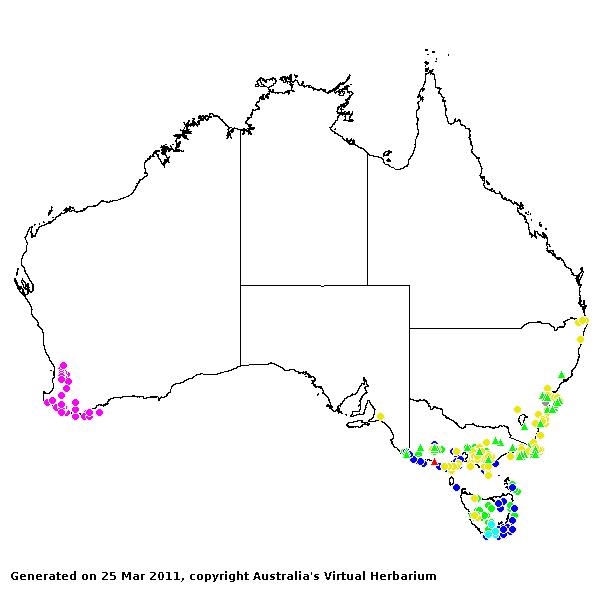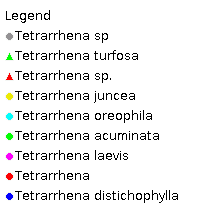Tetrarrhena Prodr. 209 (1810).
Derivation:. From tetra (four) and arrhen (male), referring to the four stamens in the florets.
Taxonomic revisions, nomenclatural references:. L.P.M.Willemse, Blumea 28: 181–194 (1982) as Ehrharta.
Key references (keys and floras):. G.Bentham, Flora Australiensis 7: 553–555 (1878); C.A.Gardner, Flora of Western Australia 1 Gramineae 21 (1952); J.W.Vickery, Flora of New South Wales, Gramineae 19: 300–302 (1975); J.C.Tothill and J.B.Hacker, Grasses of Southern Queensland 396–397 (1983); J.P.Jessop, Flora of South Australia 4: 1838–1839 (1986); B.K.Simon, Key to Australian Grasses 167–168 (1993); S.W.L.Jacobs and S.M.Hastings, Flora of New South Wales 4: 654–655 (1993); N.G.Walsh, Flora Victoria 2: 371–372 (1994); D.Sharp and B.K.Simon, AusGrass (2002); J.P.Jessop, Grasses of South Australia 60–63 (2006); S.W.L.Jacobs, R.D.B.Whalley & D.J.B.Wheeler, Grasses of New South Wales, 4th ed, 381 (2008); A.Wilson (ed.), Flora of Australia 44A: Poaceae 2: 376–380 (2009).
W.D.Clayton & S.A.Renvoize, Genera Graminum (1986), genus (syn. of Ehrharta).
Native, endemic. 3 species, from temperate and subtropical Australia. 6 species in Australia, WA, Qld, NSW, Vic, and Tas.
Habit. Perennial, stoloniferous and decumbent. Culms woody and persistent to herbaceous. Leaf blades narrow. Ligule an unfringed membrane to a fringed membrane.
Inflorescence. Inflorescence a single raceme (spike-like, the axis flexuous), a single raceme or spike.
Spikelets. Spikelets laterally compressed, more than 2 flowered, with 1 fertile floret, solitary, subsessile; with rachilla terminating in a floret. Fertile spikelets with lower incomplete floret(s), disarticulating above glumes.
Glumes. Glumes unequal, shorter than adjacent lemmas, truncate, awnless, similar (leathery to scarious). Lower glume 1 nerved. Upper glume 5 nerved.
Florets. Lower incomplete floret(s) sterile. Lemmas awnless, faintly 7 nerved, more or less equalling fertile lemmas, similar in texture to fertile lemmas (tough), not becoming indurated. Fertile florets 1. Lemmas similar in texture to glumes to decidedly firmer than glumes (leathery), not becoming indurated, entire at apex, blunt, muticous, 7 nerved, glabrous, 1 keeled to not keeled. Palea relatively long or conspicuous and relatively short, entire (acute), thinner than lemma (membranous), 1 nerved, one keeled (laterally compressed). Lodicules 2. Stamens 4 (usually) or 2. Grain compressed laterally. Hilum short. Embryo small.
Kranz Anatomy. C3.
Habitat. Shade species.
Classification. Ehrhartoideae; Ehrharteae.
Notes. Placed in synonymy with Ehrharta (Clayton and Renvoize, 1986). Recent cladistic studies(Verboom pers. com.) justify the recognition of the narrowly circumscribed genera Ehrharta, Microlaena and Tetrarrhena, retained in this key (B.K.Simon).
Types Species. T. distichophylla (Labill.) R.Br.
Biogeographic Element. Clifford & Simon 1981, Simon & Jacobs 1990: Endemic.


